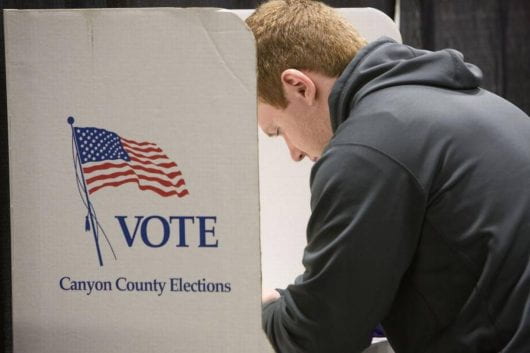
A voter at O’Connor Field House in Caldwell on Election Day. O’Connor had a long line in the May primary election, so Canyon County added additional Caldwell polling locations for November. Credit: Katherine Jones | Idaho Statesman
For over 170 years, the Associated Press has been counting votes with major success, and it has been planning for months to cover the 2022 Midterm Elections Nov. 8.
In 2020’s election, AP was 99.9 percent accurate in its calling of U.S. races and 100 percent accurate in its calling of presidential and congressional races. The work AP puts into covering an election starts months in advance with election research. According to its website, AP employs a full-time elections research staff that works year-round to ensure the newsroom, decision desk, vote counters and public know what to expect from Election Day.
Stephen Ohlemacher, election decision editor for AP, said his research team studies the election laws and processes in each state.
“Elections are very complex in the United States because it’s not one big election, it’s 50 of them — actually 51 if you count the District of Columbia,” Ohlemacher said.
Ohlemacher, a 1989 Ohio State graduate, said one aspect of elections becoming increasingly important to research is early voting because each state has its own rules surrounding early and mail-in voting. As the number of people voting early continues to grow, he said, it becomes more important to understand the advanced voting processes of each state.
“Forty-two percent of Americans voted before Election Day in 2016, 70 percent voted before Election Day in 2020,” Ohlemacher said.
Ohlemacher said it will be difficult to know how many people vote ahead of time in this year’s midterm election.
“I don’t think we’re going back to 2016,” Ohlemacher said. “I think a lot of people decided they liked voting by mail and the convenience of it, but I don’t think we’re going to have 2020 anymore because, again, we’re in a different place in the pandemic. People are probably more comfortable going to a polling place.”
Ohlemacher said on Election Day, he manages a large group of analysts who help declare the races. The group consists of 60 people who are broken up into teams.
Ohlemacher said as they call the races, the AP staffers receive a lot of help not only from analysts in Washington, but also from individuals, called “stringers,” stationed in counties across the nation.
“There are about 4,300 counties and townships across the country,” Ohlemacher said. “We send 4,000 people out there to talk directly to officials as they are counting the vote.”
Heidi Brown, election stringer coordinator for AP, said “stringers” are a vital part of covering and calling an election.
“They are either in the county election director’s office seeing how the process works as precincts are reporting in, as the election officials are counting votes, and they’re also our verification,” Brown said. “They’re our eyes and ears.”
Brown said AP compares the numbers between the online vote counts and stringer reports throughout the night. If there are any differences, the stringers verify which count is correct with the county’s election official.
Ohlemacher said AP’s election coverage is his favorite night of the year as he believes it’s the largest act of journalism in the U.S.
“It’s the Super Bowl, and it’s absolutely fantastic,” Ohlemacher said. “The newsroom is abuzz.”
Ohlemacher said some races can’t be called on election night because it takes “days, maybe even weeks after Election Day” to count all the votes.
“This is not new. It was not new in 2020. It just happened in more states in 2020,” Ohlemacher said.
Ohlemacher said AP does not make projections or predictions, and it values being correct over being first.
“We say someone has won, that’s our final word, and that is what we promise our customers — that’s our standard, ” Ohlemacher said. “Being first is not a part of my mandate: My mandate is being right.”


